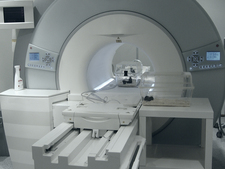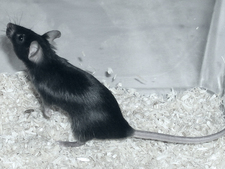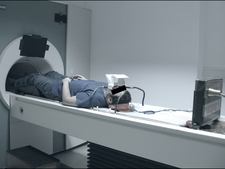Influence of static magnetic fields on reproduction and development
- From 2008 to 2011, scientists from the University of Duisburg-Essen, Germany, conducted studies on laboratory animals (mice) to answer the question of whether, and if so, how, strong static magnetic fields influence the reproduction (fertility, pregnancy) of mammals and the development of embryos as well as the further physical development of the offspring.
- The fertility of male and the course of pregnancy of female mice were not affected by repeated strong magnetic field exposure.
- The offspring exposed during embryonic development did not show any health relevant effects of exposure. However, a slightly delayed development in terms of weight and opening of the eyes was observed as compared to controls. It is possible that the developmental delay was induced by stress during exposure.
During the last few decades, magnetic resonance imaging has been applied increasingly also in pregnant women and for the purpose of gynaecologic diagnosis. In order to improve image quality, higher-performance scanners have been developed, resulting in enhanced flux density, which is why a review of biological safety is required.
Within the scope of the research project “Effects of repeated exposure to strong static magnetic fields from MRI on the end points reproduction and development in an animal model” ("Auswirkungen wiederholter Exposition mit starken statischen Magnetfeldern des MRT auf die Endpunkte Fortpflanzung und Entwicklung im Tiermodell"), lasting from 2008 to 2011, scientists from the University of Duisburg-Essen, Germany, conducted studies on laboratory animals to answer the question of whether, and if so, how, strong static magnetic fields influence the development of sperms in male adult mice, and the pregnancy and development of embryos in female mice. In addition, fertility of male and female mice exposed to static magnetic fields daily throughout the entire period of embryonic development was studied.
The results are of particular importance for the safety of both pregnant patients and medical staff.

![]() Mice in and in front of the scanner
Source: University Duisburg-Essen
Mice in and in front of the scanner
Source: University Duisburg-Essen
Method
Male and pregnant female mice were exposed at the isocentre, and at the entrance of a 1.5 Tesla and a 7 Tesla MRI Scanner 75 minutes a day for 21 days, or sham-exposed for control (0 Tesla).
Exposed males and females
Fertility of exposed males was studied by reference to sperm activity and morphology as well as to the testicular state and was found to be not affected. In females, magnetic field exposure turned out to have no influence on pregnancy rate, duration, litter size and gender distribution in the offspring. No resorptions (loss of embryos) were observed.
Offspring exposed during embryonic development
No malformations (funicular hernia, cerebral hernia, malformations of limbs) were observed among the young animals exposed during embryonic development. Eye malformations occurred in very rare cases and showed no correlation with magnetic field exposure, revealing the same frequency in unexposed and exposed animals.
Compared to controls most of the groups exposed during embryonic development were found to exhibit slightly delayed development in terms of weight and opening of their eyes, whereby the animals exposed at seven Tesla were least affected. All values were in the normal physiological range and the animals were healthy.

![]() C57BL/6 Mouse
Source: Zentralinstitut für seelische Gesundheit Mannheim
C57BL/6 Mouse
Source: Zentralinstitut für seelische Gesundheit Mannheim
Offspring fertility
Magnetic field exposure was found to have no influence on testicles and sperms in the young males exposed during their embryonic development. When mated with unexposed females, these males were just as fertile as sham-exposed animals, as measured by the pregnancy rate.
Exposure of young females during their embryonic development was observed to have no influence on the pregnancy rate, number of embryos and resorption rate subsequent to mating with unexposed males. However, the females exposed to static magnetic fields during their embryonic development exhibited significantly lighter placentas, and at seven Tesla the embryos were found to be significantly lighter, too. Although the lower weight of embryos and placentas could be indicative of an adverse effect of exposure, all embryos were healthy and normally developed.
Discussion
The animals exhibited changes in behaviour during exposure in that they obviously moved less than unexposed animals, suggesting that they had perceived the fields. In the literature there are reports suggesting that rodents can perceive static magnetic fields and experience them as annoying. This could have caused stress which in turn might have resulted in the observed developmental delay.
It has been well established in the literature that stress affects embryonic development. The research project on cognitive performance demonstrated that exposure up to seven Tesla does not induce measurable stress in humans. The above mechanism of action therefore appears to be rather unlikely in women.
The statistical evaluation of the study was designed to ensure that even slight effects were preferably not overlooked. No correction for multiple tests was made. This has the advantage that potential adverse health effects are not missed, and therefore can be largely excluded. The disadvantage is that false-positive results may occur. Whether or not this is applicable for the developmental delay can be neither confirmed nor excluded.
The cognitive and emotional behaviour of the offspring exposed during their embryonic development was studied within the scope of a second project which revealed no delay in the development of the nervous system and behaviour.
Summary
The fertility of male and the course of pregnancy of female mice were not affected by repeated strong magnetic field exposition. The offspring exhibited a slightly delayed development in terms of weight and opening their eyes, as compared to controls. It is possible that the developmental delay was induced by stress during exposure.
Influence of static magnetic fields on emotional and cognitive behaviour
- Within a research project the development of emotional and cognitive behaviour in young male and female mice regularly exposed to magnetic fields of 7 Tesla during their whole embryonic development were investigated.
- This did not result in behavioural abnormalities or differences in emotional behaviour (anxiety, depression) or cognitive behaviour (working memory, long-term memory) in the young adult age.

![]() Mouse in a T-maze
Source: ZI Mannheim
Mouse in a T-maze
Source: ZI Mannheim
The research project "Effects of repeated exposures to strong static magnetic fields from MRI during embryonic development on cognitive and emotional behaviour in mice." ("Auswirkungen wiederholter Exposition mit starken statischen Magnetfeldern des MRT während der Embryonalentwicklung auf kognitives und emotionales Verhalten bei Mäusen") was carried out between 2008 and 2011 at the Central Institute of Mental Health in Mannheim, Germany. It was linked to the study on reproduction and development, focussing on the development of emotional and cognitive behaviour (anxiety, learning ability) in male and female young animals exposed during their embryonic development.
Studies in rodents enable to systematically examine both acute and long-term effects of exposure to magnetic fields. Particularly behavioural analyses may help detect even subtle effects of exposure to magnetic fields on the developing brain. This study focussed on the behaviour of young adult mice exposed to a static magnetic field of seven Tesla flux density during the entire period of their embryonic development for 75 minutes a day.
In numerous standardised behavioural tests for both emotional behaviour (anxiety, depression) and learning or memory, no behavioural alterations could be detected as a function of exposure. In contrast, gender-specific differences were found. This indicates high sensitivity of the tests which also permit to establish even slight differences. The results show that development of behaviour and learning ability in the young animals exposed during embryonic development was normal and the slight delay in physical development, as observed in the project on reproduction, had no further negative influence.
Although results from animal experiments cannot be completely transferred to man, the results suggest that MRI examination of pregnant patients does not affect healthy development of their children.
Summary
Exposure of mice to a magnetic field of seven Tesla per day over the total period of their embryonic development did not result in behavioural abnormalities or differences in emotional behaviour (anxiety, depression) or cognitive behaviour (working memory, long-term memory) in the young adult age.
Influence of static magnetic fields on cognitive performance
- Between 2008 and 2011, the German Cancer Research Center Heidelberg and the Central Institute for Mental Health Mannheim, Germany, carried out a research project. This project addressed the question of whether, and if so, to what extent, exposure to static magnetic fields or moving within the gradients of static magnetic fields influence the well-being and cognitive performance of patients and particularly of medical staff.
- The indications from scientific literature as to the occurrence of dizziness were able to be confirmed, primarily within a magnetic field strength of seven Tesla and during movements within the gradient of a static magnetic field
- The perception of dizziness had no influence on the cognitive performance of the test persons. Most of the test persons were able to rapidly adapt to the fields and subsequently had no complaints any more.

![]() Volunteer at the entrance of the scanner
Source: DKFZ Heidelberg
Volunteer at the entrance of the scanner
Source: DKFZ Heidelberg
The research project "Effects of exposure to strong static magnetic fields on the cognitive performance of volunteers" ("Auswirkung der Exposition mit starken statischen Magnetfeldern auf die kognitive Leistungsfähigkeit von Probanden") was carried out between 2008 and 2011 at the German Cancer Research Center Heidelberg and at the Central Institute for Mental Health Mannheim, Germany. This project addressed the question of whether, and if so, to what extent, exposure to static magnetic fields or moving within the gradients of static magnetic fields influence the well-being and cognitive performance of patients and particularly of medical staff.
Absolute performance of the medical staff must be warranted in order to exclude any hazard to patients especially during surgical interventions carried out using open MRI devices.
Method
Ten different tests on attention, reaction time, memory, eye-hand-coordination, visual contrast sensitivity and visual resolution, well-being and stress were carried out within the static magnetic field of three MRI scanners with different magnetic flux densities (1.5, 3 and 7 Tesla) and a field-free space as a control under equal environmental conditions. To quantify the magnetic field strength, a measuring instrument was developed enabling simultaneous measurement of the local magnetic flux density and its time variation for individual volunteers.
Results
A total of 41 test persons (21 male, 20 female) aged from 18 to 34 were examined at all flux denisities, both within the centre of the magnet bore and when moving through a gradient of the magnetic field at the entrance of the scanner. The examination was single-blinded, i.e. test persons were not informed as to the flux density applied for testing.
Exposure to the different static magnetic fields of up to seven Tesla had no significant effects on the results of the individual cognition tests. As to well-being, the occurrence of dizziness, nystagmus (eye twitching), light flashes, and ringing in the head was found to be significantly correlated with increase in flux density. Dizziness was more pronounced at seven Tesla than under all other conditions but did not occur any more in eighty per cent of the test persons after a short adaptation period of several minutes.
Measurement of the stress hormones before, during, and after the examination based on blood and saliva samples revealed no significant effects of flux density.
The test persons’ estimates collected by means of a questionnaire as to the flux density they had been exposed to at a given day of testing revealed that blinding was successful. The test persons’ estimates of flux density were not better than random estimates.
Summary
The indications from scientific literature as to the occurrence of dizziness were able to be confirmed, primarily within a magnetic field strength of seven Tesla and during movements within the gradient of a static magnetic field The perception of dizziness had no influence on the cognitive performance of the test persons. Most of the test persons were able to rapidly adapt to the fields and subsequently had no complaints any more.
More information
- Auswirkung der Exposition mit starken statischen Magnetfeldern auf die kognitive Leistungsfähigkeit von Probanden - Vorhaben 3608S03009 (Final Report in German with abstract in English)
- Heinrich A, Szostek A, Nees F, Meyer P, Semmler W, Flor H (2011) Effects of static magnetic fields on cognition, vital signs, and sensory perception: a meta-analysis. J Magn Reson Imaging. 34(4): 758 - 763
- Heinrich A, Szostek A, Meyer P, Nees F, Rauschenberg J, Gröbner J, Gilles M, Paslakis G, Deuschle M, Semmler W, Flor H (2013) Cognition and sensation in very high static magnetic fields: a randomized case-crossover study with different field strengths. Radiology. 266(1): 236 - 245
- Gilles M, Paslakis G, Heinrich A, Szostek A, Meyer P, Nees F, Rauschenberg J, Gröbner J, Krumm B, Semmler W, Flor H, Meyer-Lindenberg A, Deuschle M. (2013) A cross-over study of effects on the hypothalamus-pituitary-adrenal-(HPA-) axis and the sympathoadrenergic system in magnetic field strength exposure from 0 to 7 Tesla. Stress 16(2): 172 – 180
- Groebner J, Umathum R, Bock M, Krafft AJ, Semmler W, Rauschenberg J (2011) MR safety: simultaneous B0, dΦ/dt, and dB/dt measurements on MR-workers up to 7 T. MAGMA. 24(6): 315 - 322
Heinrich A, Szostek A, Meyer P, Reinhard I, Gilles M, Paslakis G, Rauschenberg J, Gröbner J, Semmler W, Deuschle M, Meyer-Lindenberg A, Flor H, Nees F (2014) Women are more strongly affected by dizziness in static magnetic fields of magnetic resonance imaging scanners. Neuroreport, 25(14):1081-1084